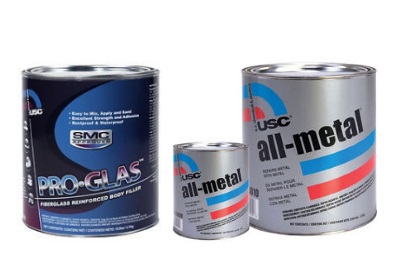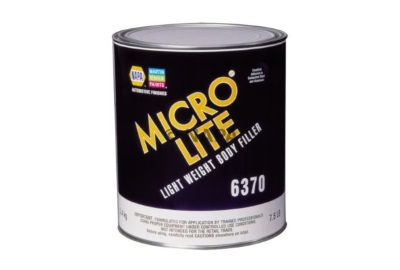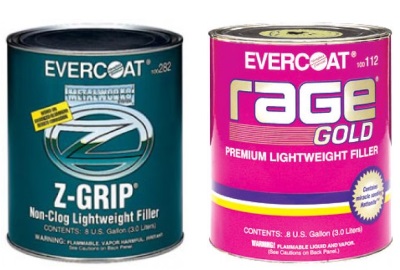Whether you are performing a body off restoration or repairing dents and door dings, Knights Auto Parts and Paint has the auto body fillers you need to achieve professional results. We carry a full selection of Evercoat, NAPA, USC and others.
BODY FILLER
BODY FILLER OVERVIEW
Our professional staff can help you select the right kind of auto body filler for your vehicle. Whether you drive a passenger car or medium sized truck or SUV, our staff strive to ensure that you get the perfect body filler to make it look great! We carry Fiber Glass, Polyester, Lightweight, Thinners, and other types of body fillers.
What Exactly is Body Filler?
Ever wonder what Bondo, (the body filler brand name turned generic), is made of and how it works? Well, so did we, and that made us do a little investigating into its makeup. It turned out to be harder than we thought to determine the exact chemistry of these materials, but what we found is enough to make some sense of it all.
Body fillers are materials that use a catalyst to harden. Anyone who has ever mixed up a batch knows that, of course, but few know that the red (sometimes blue) catalyst is MEK peroxide. The “MEK” stands for methyl ethyl ketone, an aromatic chemical compound that is rather dangerous to one’s health, hence the warnings on the filler labels that tell you to use the materials in a ventilated area or use a proper respirator. So much for that part of the mix.
The filler itself is a complex mixture of goop that contains, among other things, fiberglass (polyester) resin and talc. The resin allows adhesion as good as most epoxy adhesives and the talc (yes, as in talcum powder) makes the material flow smoothly. Talc is hygroscopic (that is, it absorbs moisture) unfortunately, and that’s the reason fillers absorb water. The main solvent in the filler is styrene, which vaporizes as the mixture cures. Bubbles in the filler occur when the mixture cures too fast, trapping the styrene gas.
Body fillers are thermal-set plastics. That is, they cure with heat (created by the chemical reaction between the filler and the catalyst) and become hard and stable, usually within a few minutes. Too much hardener will cause the cured material to become brittle and crack, while too little delays a cure almost indefinitely.
Temperature is very critical to exothermic (the fancy, scientific name for catalyst-induced heat) reactions. In fact, curing is drastically slowed below 64 degrees F ambient air temperature, to the point that it can easily take several days. The best temperature to use filler is between 70-80 degrees F, and that includes the metal you’re applying the filler to!
If the metal is cold the mixture will cure from the outside in, trapping moisture against the metal surface. It can also trap unvaporized solvent, which could come back later to haunt you if you paint over it too soon.
Mixing the filler on cardboard isn’t a great idea, since the paper itself will absorb some of the styrene solvent and upset the chemistry. Also, the styrene will release any trapped chemicals in the cardboard, so unless you know precisely where the material came from and how it was handled, use a sheet of glass or plastic or freezer paper.
Body Filler Shelf Life
How To Video
So How Does Body Filler Stick?
Body fillers stick to the metal through mechanical means. The smoother the metal, the less perfect the adhesion will be, which is why the instructions always tell you to rough-sand the metal surface. Those scratches allow the Bondo to stick very well and for a very long time, assuming there’s no rust layer.
Since we know that fillers stick best to metal, it stands to reason that spreading them over primed metal surfaces can lead to separation later. That’s true, but if the surface is still scratched and rough the filler will tend to stick extremely well. If you use an etching primer you must make sure it is properly cured before using filler. Otherwise, the phosphoric acid vapors left over can slow down the cure of the filler resin.
How Thick Can I Apply Body Filler?
This is always an issue with body repair and one with no absolutely clear answer. There are cars with two inches of filler that go for years with no problems, and then there are cars with a paper-thin layer that lifts off within months. It seems, therefore, that the “secret” of filler’s success or failure is the underlying surface.
The technical data seems to indicate that a 1/8th inch layer is perfectly safe, and building up layers to 1/4 inch shouldn’t cause failure later on. This assumes that the underlying metal is stable, solid and rust-free. Cracks and holes must be welded because any movement in the metal will crack the filler on top. If your car is of unibody construction, bear in mind that the whole thing twists as it travels along the road. Make sure the metal structure is absolutely correct and you shouldn’t have any difficulties.



